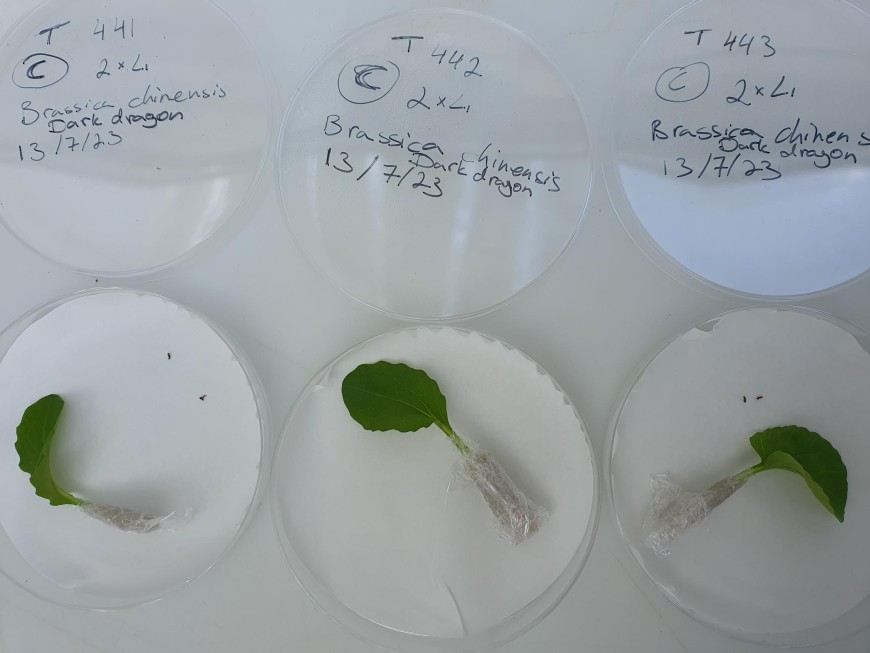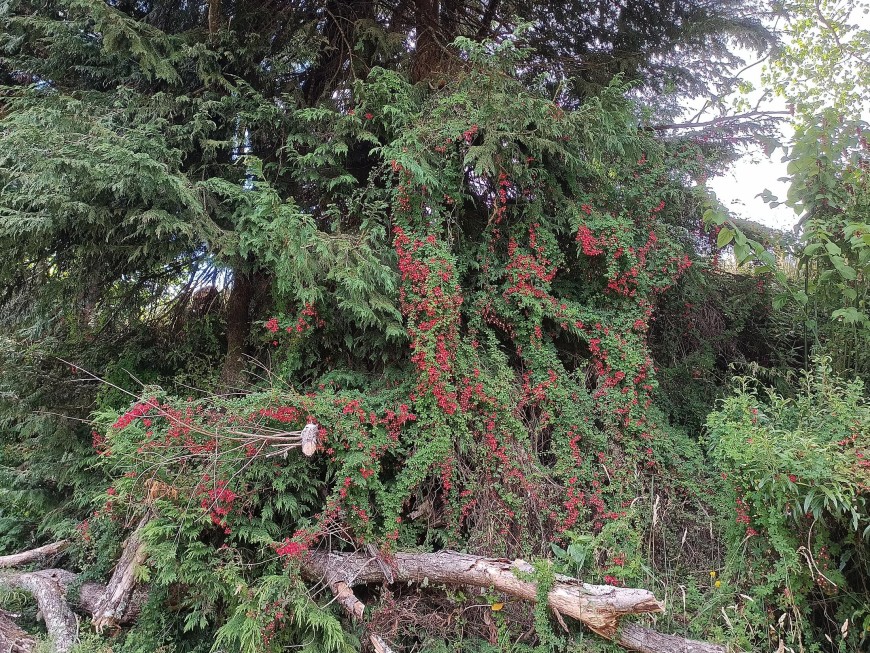Chilean Flame Creeper Beetle Passes the Test
Following preliminary work on the beetle in Chile, our collaborator Hernán Norambuena travelled to New Zealand in November 2022 with a precious cargo of around 65 reproductive adult beetles and 450 eggs. Host range testing began immediately, and the results were mostly very promising. However, there remained a question about the potential risk to one species in the cabbage family (Brassicaceae), pak choi dark dragon (Brassica chinensis).

Image: Chilean flame creeper leaf beetle tested on pak choi.
In the initial tests a few larvae nibbled on the leaves of pak choi, and one individual completed development to the adult stage. We then conducted an analysis using the Relative Performance Index developed by Senior Researcher Quentin Paynter. The index helps us predict whether low levels of feeding on non-target test species in the artificial testing arena are likely to translate to serious non-target feeding in the natural environment. A score of 0 means the candidate agent did poorly on the test (non-target) species compared to how it did on the target weed. A score of 1 means the candidate agent did equally well on the test species and on the target weed. A score below a certain threshold corresponds with no non-target feeding in the natural environment, whereas a score above the threshold means there is a realistic likelihood for non-target feeding to occur in the natural environment.
The score result from the initial testing for pak choi was below the threshold - but close to it. We decided that more testing was required to increase our confidence that this important vegetable was going to be safe. “Luckily, we discovered that the beetles remain active and reproductive if maintained at warm temperature, and do not require overwintering. This enabled us to run additional tests on pak choi with no delays,” explained Ronny Groenteman, who oversees this programme. “We ran a great deal more replicates, and at the end of this set of tests we were confident that pak choi was not going to be a field host for the beetle,” she added.
Robyn White, who conducted the additional testing, commented that “Only a handful of larvae attempted nibbling on pak choi. All but one larva died as first instar without feeding at all or after a small nibble, and only one larva made it to second instar before dying. No larvae made it beyond second instar on pak choi, while 42% of replicates on Chilean flame creeper had at least one larva make it to pre-pupal stage, and 22% of replicates had at least one larva make it to adult.”
In the meantime, we had asked Hernán to complete two more tasks to give us further reassurance that brassica crops are safe from attack by the leaf beetle. Firstly, we asked him to search the Chilean literature in Spanish, such as farming magazines and information pamphlets, to look for any reports of the beetle in association with brassica crops. Secondly, we asked him to visit field sites where unsprayed brassica crops are grown near Chilean flame creeper sites, where the beetles are also present.
Fortunately, both these tasks yielded the results we were hoping for. Hernán located numerous literature items associated with the main brassica crop in Chile, rape seed (Brassica napus; cultivated for oil), and other brassica crops such as cabbage and cauliflower. Despite brassica crops being grown in Chile frequently, even as far back as the 19th century, the literature did not mention the leaf beetle as a pest. “I have also consulted with several entomologists, agronomists and growers of rape seed or other brassica crops, and they all confirmed they are not aware of beetles of the distinct shape and colours of the Chilean flame creeper beetle ever seen in association with these crops,” explained Hernán.

Image: Chilean flame creeper.
In his field surveys Hernán visited large fields of unsprayed rape seed crops in Chile’s Araucania region, as well as other smaller fields of Brassica crops such as cabbage, cauliflower, kale, arugula, and radish. He also surveyed field mustard plants, including those found at the Chilean flame creeper site where the beetle was first detected in 2019. “The region of the surveys is currently under a state of emergency due to indigenous rights land disputes. Nevertheless, it was the most logical region to survey since there are sites with the highest early records of the leaf beetle and is the largest rape seed cropping area” said Hernán.
The crops’ distance from the nearest Chilean flame creeper with the leaf beetle ranged between 30 m and 25 km. The beetle was absent from all surveyed brassica crops. Other insects were present in those crops, such as honeybees, pests such as aphids, leaf miners, and the diamond back moth, and natural enemies such as parasitic wasps, hoverflies, and ladybird beetles. This survey serves as another level of evidence for the host specificity of the Chilean flame creeper leaf beetle.
With the host range testing, literature search, and field surveys all painting a consistent picture that the leaf beetle is host specific to species in the plant genus Tropaeolum, we are finally preparing for Māori and stakeholder consultation and writing up the release application for the Environmental Protection Authority.
Funding
This project was funded by the Ministry for Primary Industries’ Sustainable Food and Fibre Futures Fund (Grant S3F20095) and the National Biocontrol Collective.
